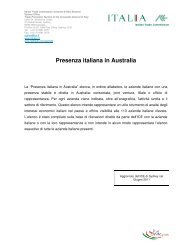Price Determination in the Australian Food Industry A Report
Price Determination in the Australian Food Industry A Report
Price Determination in the Australian Food Industry A Report
You also want an ePaper? Increase the reach of your titles
YUMPU automatically turns print PDFs into web optimized ePapers that Google loves.
The consumer trend towards eat<strong>in</strong>g out of <strong>the</strong> home places pressure on major food retailers <strong>in</strong><br />
achiev<strong>in</strong>g growth <strong>in</strong> food sales from <strong>the</strong>ir retail formats and will cont<strong>in</strong>ue to cause <strong>the</strong>ir category<br />
managers to seek products which <strong>in</strong>crease <strong>the</strong> convenience appeal to customers.<br />
The five external factors that determ<strong>in</strong>e prices (refer figure 123)<br />
Supply dynamics<br />
The nature of product supply will have a major impact on pric<strong>in</strong>g over time. As noted, pric<strong>in</strong>g will<br />
be <strong>in</strong>fluenced by <strong>the</strong> seasonality of availability <strong>in</strong> fresh product l<strong>in</strong>es, though major retailers<br />
attempt to smooth costs by sourc<strong>in</strong>g from suppliers capable of deliver<strong>in</strong>g year-round supply. This<br />
approach extends to products which are affected by <strong>in</strong>ternational trade – suppliers hold<strong>in</strong>g large<br />
quantities of commodity l<strong>in</strong>es <strong>in</strong> times of export downturn may offer lower prices to move volumes<br />
through retail as part of a promotional program (such is <strong>the</strong> case with block cheese).<br />
Retail buyers will have greater ability to <strong>in</strong>fluence buy<strong>in</strong>g prices <strong>in</strong> fragmented <strong>in</strong>dustries than <strong>in</strong><br />
those that are concentrated. In fragmented sectors, commodity conditions prevail.<br />
The nature and quality of <strong>in</strong>formation will have a bear<strong>in</strong>g on pric<strong>in</strong>g. Where <strong>the</strong>re is room to move,<br />
transparency on <strong>the</strong> true costs of products will have a bear<strong>in</strong>g on <strong>the</strong> contribution that is sought<br />
towards category targets.<br />
Product attributes<br />
The nature of <strong>the</strong> product itself will dictate <strong>the</strong> costs of handl<strong>in</strong>g and <strong>the</strong> requirements of display<br />
and <strong>in</strong>-store servic<strong>in</strong>g. Higher product marg<strong>in</strong>s will be sought on higher cost l<strong>in</strong>es such as fresh<br />
fruit and vegetables, where shr<strong>in</strong>kage, labour and capital costs require greater gross marg<strong>in</strong>s to<br />
cover <strong>the</strong>se <strong>in</strong>vestments.<br />
The effect of compet<strong>in</strong>g products<br />
<strong>Price</strong> <strong>Determ<strong>in</strong>ation</strong> <strong>in</strong> <strong>the</strong> <strong>Australian</strong> <strong>Food</strong> <strong>Industry</strong> A <strong>Report</strong><br />
Competition for <strong>in</strong>dividual products may come <strong>in</strong>side <strong>the</strong> store from directly compet<strong>in</strong>g l<strong>in</strong>es (for<br />
example, meat l<strong>in</strong>es with<strong>in</strong> red meats or between chicken and red meat cuts, or to shift buy<strong>in</strong>g<br />
patterns to private label from proprietary brands), from different formats (frozen versus fresh<br />
vegetables, semi-prepared packag<strong>in</strong>g versus conventional basic product) or from product<br />
substitutes (pasta versus rice versus o<strong>the</strong>r sources of carbohydrates).<br />
The retailer will take account of <strong>the</strong> contribution of each product to <strong>the</strong> category and store targets<br />
when sett<strong>in</strong>g prices.<br />
The existence of compet<strong>in</strong>g retailers and different formats<br />
Major cha<strong>in</strong> retailers compete with a myriad of <strong>in</strong>dependent cha<strong>in</strong>s and specialty food retailers <strong>in</strong><br />
buy<strong>in</strong>g and sell<strong>in</strong>g. Supermarkets use <strong>the</strong>ir one-stop shopp<strong>in</strong>g, convenience and low prices to<br />
attract <strong>the</strong> consumer at all po<strong>in</strong>ts and negotiate <strong>the</strong> best buy<strong>in</strong>g prices from suppliers.<br />
Work presented to <strong>the</strong> Senate by <strong>the</strong> <strong>Australian</strong> Competition and Consumer Commission regard<strong>in</strong>g<br />
prices paid to suppliers by retailers showed that <strong>the</strong>re were two levels of terms accessible by<br />
retailers and wholesalers. The commission noted that whilst <strong>the</strong> major cha<strong>in</strong>s did achieve better<br />
deals more often than <strong>the</strong> <strong>in</strong>dependent wholesalers, <strong>the</strong>y did not always receive higher terms from<br />
<strong>the</strong> same suppliers. This <strong>in</strong>dicates <strong>the</strong> market at work with suppliers vary<strong>in</strong>g <strong>the</strong>ir deals where <strong>the</strong>y<br />
achieved best performance for <strong>the</strong> terms paid, whe<strong>the</strong>r <strong>the</strong> buyers were <strong>in</strong>dependent wholesalers<br />
or major cha<strong>in</strong> retailers.<br />
At a category level, retail products are <strong>in</strong>creas<strong>in</strong>gly compet<strong>in</strong>g with <strong>the</strong> growth <strong>in</strong> food service<br />
demand.<br />
118







